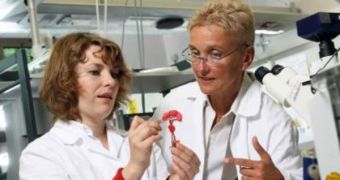For a long time, animal rights activists have argued that testing all sorts of new cosmetic products or drugs on apes, dogs and other species is unethical, and have also lobbied for the practice to be abolished. Rather than criticizing the activists, like others in the industry, researchers at the Fraunhofer Institute for Interfacial Engineering and Biotechnology IGB, in Stuttgart, Germany, have developed an artificial organ system, which could be employed for the same tests animals are used today. However, the new experimental device is a lot more accurate, and more closely linked to the human physiology.
“Our artificial organ systems are aimed at offering an alternative to animal experiments. Particularly as humans and animals have different metabolisms. 30 per cent of all side effects come to light in clinical trials,” Fraunhofer Institute Professor Heike Mertsching explains the reasons for her work. The new system, which was developed jointly by Mertsching with colleague Dr. Johanna Schanz, was awarded the “Human-centered Technology.”
“The special feature, in our liver model for example, is a functioning system of blood vessels. This creates a natural environment for cells. We don't build artificial blood vessels for this, but use existing ones – from a piece of pig's intestine,” Schanz says. All of the cells belonging to the animal are removed from the vessels, which are then inoculated with human blood cells, so as to create the most relevant research medium for the work at hand. In studies of the liver, whose complex functions have had researchers perplexed for quite some time, the model has to be as closely related to its human equivalent as possible, investigators say.
Among the human cells that are placed in the pig entrails, the researchers mentioned hepatocytes, which play an important part in breaking down and assimilating drugs, as well as endothelial cells, which create the boundary between blood and tissue cells. The entire model is then placed into an IGB-patented bioreactor, where it's left to grow. Blood flow is achieved through the use of a computer-controlled pump, which enables nutrient solutions for the cells to be pumped in and then evacuated.
“The cells were active for up to three weeks. This time was sufficient to analyze and evaluate the functions. A longer period of activity is possible, however,” Schanz added. In other hepatic models, blood cell circulation was never achieved, the expert mentioned.

 14 DAY TRIAL //
14 DAY TRIAL //